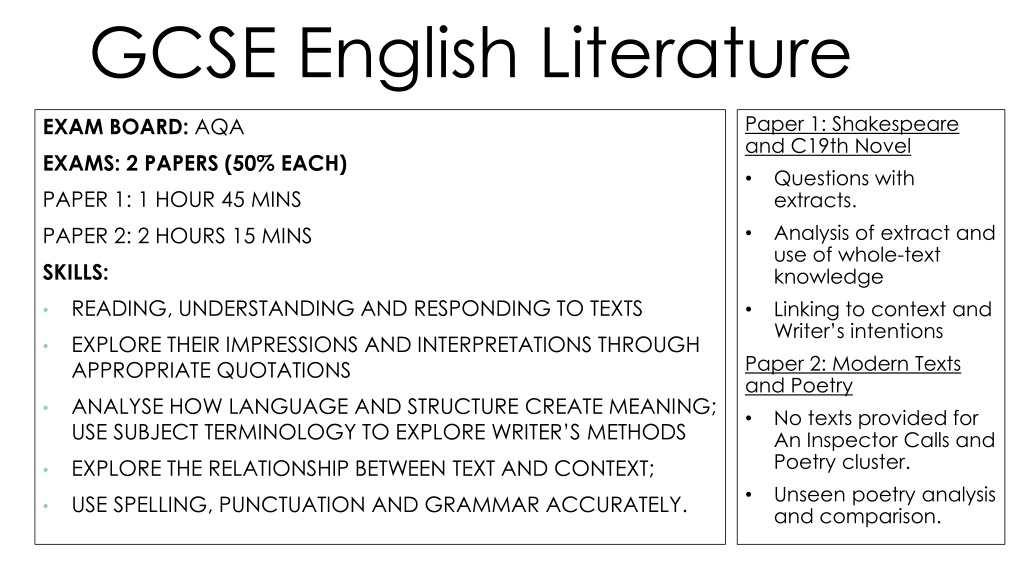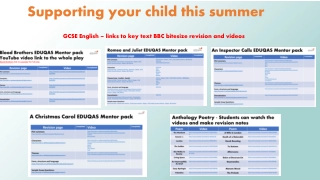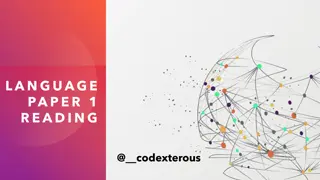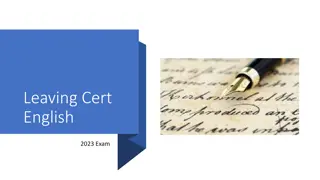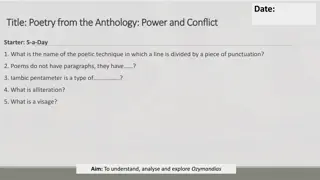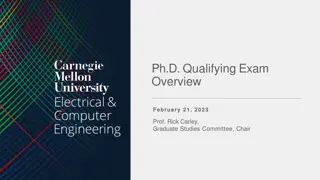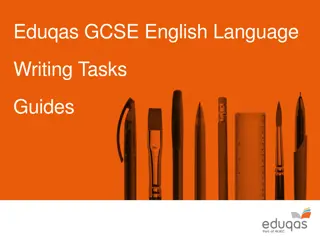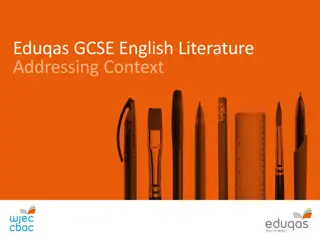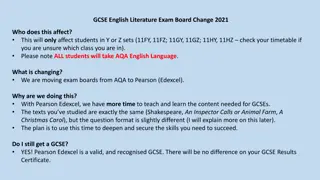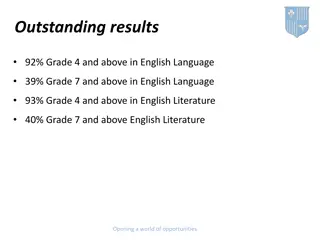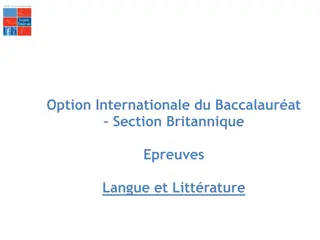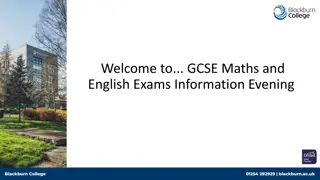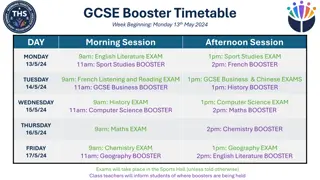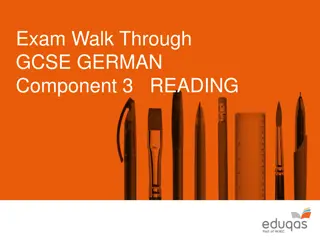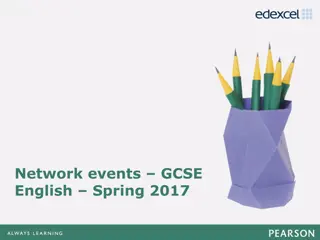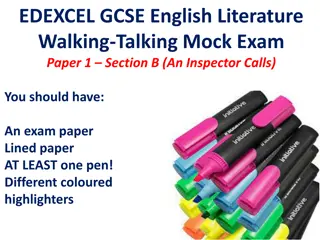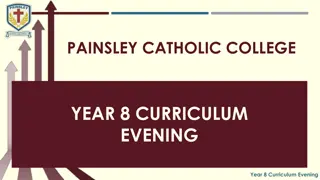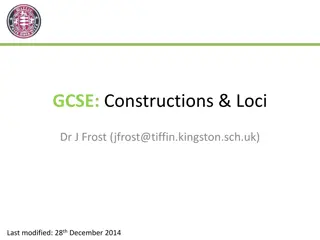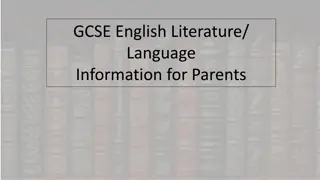Exam Preparation Guide for GCSE English Literature and Language
Prepare effectively for your GCSE English Literature and Language exams by understanding the requirements of each paper, practicing with provided extracts and models, creating your own questions and responses, and analyzing texts with contextual knowledge. Enhance your skills in analyzing language, structure, and writer's intentions, and improve your writing abilities for different tasks such as describing, narrating, arguing, and persuading. Utilize step-by-step instructions and practice questions to master the content and excel in both papers.
Download Presentation

Please find below an Image/Link to download the presentation.
The content on the website is provided AS IS for your information and personal use only. It may not be sold, licensed, or shared on other websites without obtaining consent from the author. Download presentation by click this link. If you encounter any issues during the download, it is possible that the publisher has removed the file from their server.
E N D
Presentation Transcript
GCSE English Literature Paper 1: Shakespeare and C19th Novel Questions with extracts. Analysis of extract and use of whole-text knowledge Linking to context and Writer s intentions Paper 2: Modern Texts and Poetry No texts provided for An Inspector Calls and Poetry cluster. Unseen poetry analysis and comparison. EXAM BOARD: AQA EXAMS: 2 PAPERS (50% EACH) PAPER 1: 1 HOUR 45 MINS PAPER 2: 2 HOURS 15 MINS SKILLS: READING, UNDERSTANDING AND RESPONDING TO TEXTS EXPLORE THEIR IMPRESSIONS AND INTERPRETATIONS THROUGH APPROPRIATE QUOTATIONS ANALYSE HOW LANGUAGE AND STRUCTURE CREATE MEANING; USE SUBJECT TERMINOLOGY TO EXPLORE WRITER S METHODS EXPLORE THE RELATIONSHIP BETWEEN TEXT AND CONTEXT; USE SPELLING, PUNCTUATION AND GRAMMAR ACCURATELY.
GCSE English Language Paper 1: Explorations in creative reading and writing An extract from an unseen fictional text Analysis of language and structure Evaluation of impact Writing to describe / narrate Paper 2: Viewpoints and Perspectives Two unseen non- fiction texts (one C19th) Summary, comparison and language analysis. Writing to argue / persuade. EXAM BOARD: AQA EXAMS: 2 PAPERS (50% EACH) PAPER 1: 1 HOUR 45 MINS PAPER 2: 1 HOURS 45 MINS SKILLS: SUMMARISING A TEXT (PULLING OUT KEY DETAILS) SIMILARITIES / DIFFERENCES BETWEEN THE ATTITUDES / IDEAS OF 2 TEXTS IDENTIFYING EFFECTIVE LANGUAGE CHOICES IN A TEXT IDENTIFYING STRUCTURAL CHOICES IN A TEXT AND THEIR IMPACT USING APPROPRIATE TERMINOLOGY COMMENTING ON THE EFFECT OF WRITERS CHOICES ON THE READER. WRITING TO DESCRIBE OR NARRATE WRITING TO ARGUE OR PERSUADE
Knowing the texts well, and how to select appropriate ideas and quotes to answer the question is key. There are a range of practice questions, extracts and models on the school website which students can download. Alternatively, they can create their own from the texts they have studied. Read the extract and question with your child. Together, create a list of ideas from the extract which they could use to answer the question. Help them to highlight all phrases they could use to support these ideas. Read the extract and explain how it fits in with the events of the rest of the text. What has led to the events in the extract? What are the consequences of the extract? Read through a model and map out how the student has written it. Create step-by-step instructions which guide you through what the students does / says in their response. Use this step-by-step guide to write your own response to a different question. Take an extract and create your own question by: Identifying the key theme of the extract. Phrasing the question so that a response focuses on the extract and the whole text. Read the extract and create a mind-map of the contextual (social, historical, political issues influencing the writer) issues which may have influenced this particular moment of the text. Consider in your notes, what the writer is trying to say about these issues.
How does the extract fit into the rest of the text? Before Hyde has already attacked a young girl. He has subsequently murdered Carrew (attacks are becoming more violent and no one is safe) London feels oppressed and fearful because of the random nature of these attacks > oppression of the weather in the extract. After Later setting reflect mystery and tension, e.g. The Red Baize Door . Just as the fog dominates London (physically and mentally), Hyde becomes more dominant and powerful while Jekyll weakens. Hyde is no longer able to change back into Jekyll his power is total; his last resort is to commit suicide.
Borrow sentence starters from a good model In the extract, Dickens describes the Phantom slowly, gravely, silently approaching. Dickens uses this list of adverbs to create the impression that just as the Phantom is approaching, Scrooge s fears are also approachingwhich frightens Scrooge and the reader because it parallels our own fears coming closer to us. Furthermore, through the use of these adverbs, Dickens is also trying to highlight to the reader how fear comes for us all and is inescapable but if you are good and kind then fear cannot destroy you but strengthen you. Dickens wanted to persuade Victorian people to relinquish their own meanness and selfishness because people who are mean and selfish have more to fear than those who are good. He believed in embodying the Christmas spirit and expressing it in our everyday lives because in doing so you will have less to fear and be able to cope better with fear he wanted to convey this allegorical message to his Victorian readers because Dickens saw and experienced a lot of selfish and horrible behaviour, especially towards the poor in Victorian times and was determined to change this through writing A Christmas Carol . Students can insert their own ideas into the spaces. By doing this, they are left with more sophisticated sentence openings, which forces them to write in a more sophisticated style. This is a good way to practice writing response.
Focus on the context you could explore Macbeth is evidence of Shakespeare creating texts to appeal to the interested of his audience: James 1 (James VI of Scotland) was interested in and wrote essays on witchcraft and the supernatural. He was distrustful of it and the play serves to show the destructive impact it has on society. The prophetic qualities of the supernatural tap into monarchical insecurities at the time. The transition from Tudor to Stuart was unsettling (both in terms of the monarch s nationality and religion) and is echoed in the way the kingdom crumbles and war breaks out, when Macbeth, who is not the rightful king, takes power.
For both exams, the students will need to know a range of quotes from each of their texts. Learning quotes Students can create their own quote revision tasks such as the one below. Look, cover, write, check is an effective memorisation strategy: Column One Full Quote It's not my business," Scrooge returned. It's enough for a man to understand his own business, and not to interfere with other people's. Mine occupies me constantly. Column Two Fill in the missing words Column Three Write out the full quote It's not my _________________," Scrooge returned. It's enough for a man to _________________ his own business, and not to _____________ with other people's. Mine ______________ me _________________. Self testing, and peer testing are good ways to memorise these. The use of quotes is also important. Students should aim to learn quotes which can be used in multiple ways to explore multiple ideas.
Themes: social injustice, greed and isolation. Links to: This boy is Ignorance, This girl Want. Beware them both. the main causes of suffering in society. Triplet all three words connote distance, and unfriendliness, emphasising that it is Scrooge s choice to live this way. A sinister. Harsh sound to reflect his unfriendliness. Doesn t need anyone else to survive. Sibilance secret, and self-contained, and solitary as an oyster Locked away; kept away from others; guarded Hard shell or barrier against others. Perhaps from fear or dislike. Behaviour is unfriendly and distant. Simile Scrooge is reflection of the wealthy upper classes in Dickens time who turned a blind eye to the suffering and poverty of the working class and vagrancy. Dickens intention is to show their selfishness, in contrast to the sense of community among the poor of his novel.
Planning Help them to organise their ideas and plan a response. Encourage them to do the following: 1. Read the question and highlight the key words; 2. Highlight and annotate the relevant sections of the text; What choices have been made and what impression / atmosphere do they create? 3. How could these ideas be linked to other parts of the novel? 4. Note down ideas which you can use to answer. Use arrows and numbers to divide these into paragraphs.
You can find past papers and mark schemes here: https://www.aqa.org.uk/exams- administration/exams-guidance/find-past-papers-and-mark-schemes Useful websites for texts: GCSE Bitesize has useful pages for all AQA literature texts: https://www.bbc.com/bitesize/examspecs/zxqncwx Mr Bruff on Youtube delivers some accessible videos on the key texts: https://www.youtube.com/channel/UCM2vdqz-7e4HAuzhpFuRY8w
